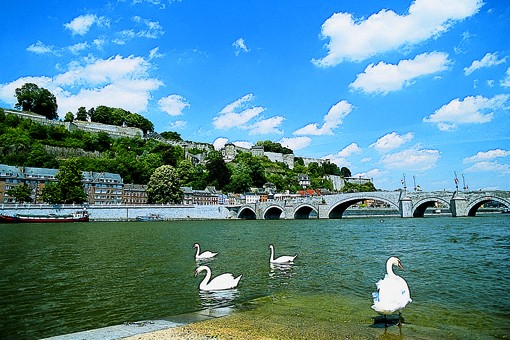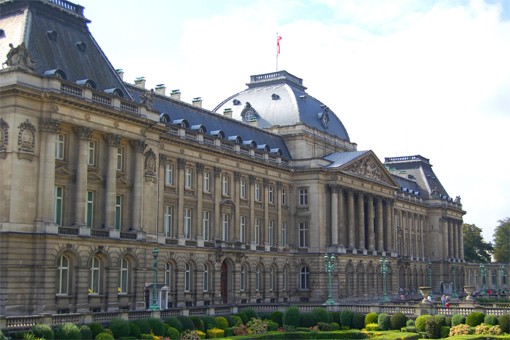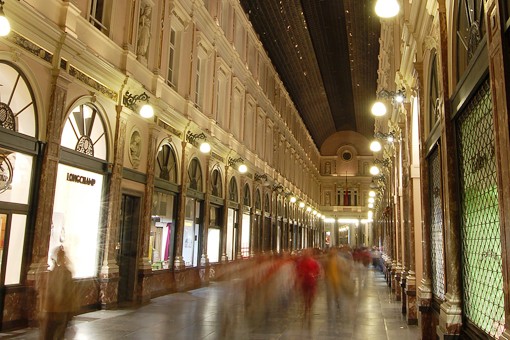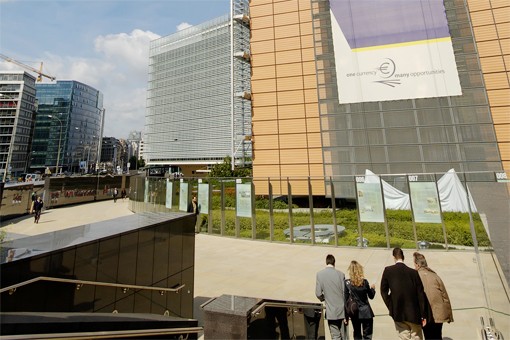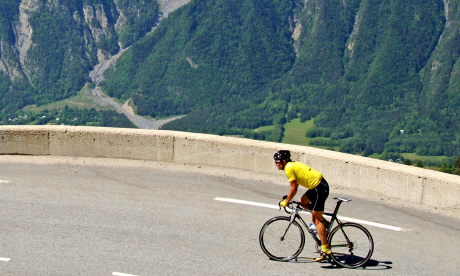
Fancy feeling your legs burn? Check out these top four cycle climbs in Europe, taken from Daniel Friebe and Pete Goding's new book 'Mountain High'
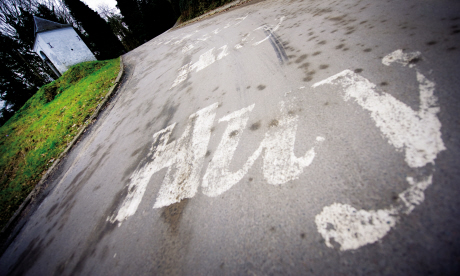 1. Mur de Huy, Belgium
1. Mur de Huy, BelgiumHow bad can a 1.3 kilometre climb be? Philippe Gilbert, the local Walloon hero, said that to one day conquer the Mur and win the Flèche Wallonne, the Belgian one-day race to which its folklore is inextricably linked, he would have to endure ‘two minutes of suffering’.
And therein lies the problem: what for Philippe Gilbert was two minutes of torture, for anyone not among the finest riders in the world might mean an agony of double or triple the duration – not to mention equal, if not more excruciating, pain.
‘The Tour of Flanders has the Muur, Amstel Gold has the Cauberg and Liège–Bastogne–Liège has La Redoute… but the Mur de Huy is by far the hardest of the lot,’ opined Claude Criquielion, winner of the first Flèche to finish atop the Mur, in 1983.
The road or wall’s significance, of course, far predates and transcends its sporting legend. Historically and still officially known as the Chemin des Chapelles or Chapel Way, the road soars out of the rue du Marché in Huy and towards Notre Dame de la Sarte, the last of seven chapels dotted up the hillside and supposedly the scene of a miracle in 1621. Pilgrims stop at all seven before ending their journey at Notre Dame. For cyclists, a glimpse of the church steeple heralds the imminent end of the climb and their deliverance.
An encyclopedia of Belgian cycling climbs published in 2004 rated the Mur only the country’s 34th hardest ascent, well adrift of the 4.6 kilometre, 6% Col d’Haussire in La Roche-en-Ardenne.
The Mur’s extreme and unorthodox proportions, though, render any such ranking system meaningless; while only 800 metres of its 1.3 kilometres are truly difficult, that stretch is steeper and more brutal than anything else in professional cycling. The Frenchman Laurent Jalabert, who triumphed twice on the Mur, reckoned that only the Mont Saint-Clair above Sète in the south of France (1.7 kilometres long, average 10%, maximum 24%) could compare or compete. Flèche Wallonne race director Christian Prudhomme called the Mur ‘the longest kilometre of the racing season’ and ‘basically a mountaineering competition’.
A mazy cavalcade through the wooded mining valleys of the Belgian Ardennes, the Flèche’s route has been tweaked in recent years, but the Mur remains its centrepiece. Depending on the year, the peloton climbs its ramps either once or twice before a final, frantic scramble to the summit. Since Criquielion’s victory in 1983, Lance Armstrong, Michele Bartoli, Moreno Argentin, Cadel Evans, Maurizio Fondriest and Laurent Fignon have all won here; other Classics legends such as Paolo Bettini, meanwhile, have repeatedly tried and failed to get the measure of the Mur.
In 2002, unfancied home rider Mario Aerts was clear in a six-man breakaway group when the Mur loomed for the last time. The next few minutes, which culminated in the Belgian crossing the line with arms aloft, Aerts will never forget.
‘It’s just an incredible feeling,’ he recalled in 2011. ‘There are so many people – it’s like being in the middle of a rock concert or football match… Once you start the climb it’s not that steep, but you know what’s coming. The climb is basically only two corners, but if you take them on the inside, they’re 25%, and if you go on the outside you’re obviously penalising yourself because it’s further. After the bends, the road straightens and the slope eases for the last 200 metres, but they last an eternity. The key is to really dose your efforts and keep something back for those last 200 metres. If you’re lucky and strong, having gone up the climb in a 39x21 gear or even 23, you can manage that final bit with a 39x19.’
Victorious in gripping duels with Maurizio Fondriest and Luc Leblanc on the Mur in 1995 and 1997 respectively, Jalabert agreed in 2005 that economy was the key. ‘The difficulty of the Mur is its length and its gradient – but also the altitude you gain with every step, because it’s essentially a staircase,’ the Frenchman explained. ‘You have to know how to use your gears to save energy. You always just have to hold a little bit back and be aware of how far you’ve got to go to the summit. That said, on the steepest parts, it’s purely a question of strength and energy. Everyone is in their smallest gear. Later, when it eases slightly at the end, you can get away with a 39x21 or 39x19.
While Aerts and Jalabert can blithely compare notes about gear ratios, and Philippe Gilbert console himself with the brevity of the ordeal, amateur cyclists should be aware that, for them, the Mur will be a test of survival. On the two bends that give the climb the feel and gradient of a helter-skelter in its middle section, merely staying upright can be a challenge. Even bike fans familiar with TV pictures of the Flèche Wallonne and its Mur are often astonished when they stand at its base for the first time.
Short but steep, not sweet, the Mur may very well be Belgium’s most fearsome climb. It is certainly among its most infamous. Bettini used to say it was simply ‘too hard’. He had no Flèche Wallonne in his palmarès – but the Italian may have had a point.
Region: Wallonia, southern Belgium
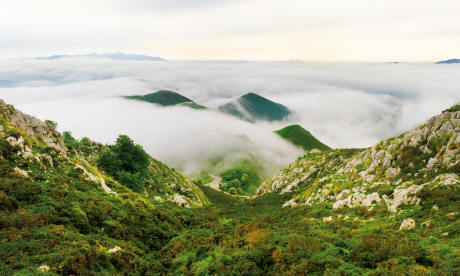 2. Lagos de Cavadonga, Spain
2. Lagos de Cavadonga, SpainSpanish journalist Juanfran de la Cruz observed a few years ago that, like all sports, cycling has many myths and legends, but also the peculiarity that some are made of flesh and bone and others of tarmac road. ‘The ascent to the Lagos de Covadonga,’ de la Cruz wrote in 20minutos, ‘belongs to the second category, like Alpe d’Huez or the Tourmalet in France, like the Mortirolo or the Marmolada (Passo Fedaia) in Italy.’
If he was reading, Vuelta a España boss Victor Cordero at the time would have smiled. In the early 1980s, Cordero’s predecessor Enrique Franco set out to find Spain’s answer to Alpe d’Huez – the climb that had become a Tour de France icon in the space of a few years since the mid-1970s; never mind the mercury, iron and magnesium mined at La Bufferera near the summit, at Covadonga, Franco sensed he’d struck gold. Not long but devilishly steep and with two evil ramps at La Huesera and the Mirador de la Reina (literally The Queen’s Look-Out), the Lagos could also boast something with which the Alpe wasn’t particularly blessed: unspoilt natural beauty. With its two lakes beneath the summit, the Enol and the Ercina, and stunning views over the Picos de Europa, the site seemed the perfect antidote to the barren and indistinguishable summits of the deep south and the Sierras around Madrid.
The 1983 Vuelta would, then, see two firsts: the first trip to the Lagos and the first stages broadcast live on Spanish television. Franco’s new discovery would therefore get maximum exposure. Ironically, it also turned out to be the last ever stage that his successor Cordero’s wife ever watched from the race course and not in front of the couple’s television set at home.
‘On the first left-hand bend, our car’s front right wheel went over the edge and we nearly fell into the ravine,’ Cordero, manager of the Zor team in that 1983 Vuelta, remembered in 2008. ‘It really shook up my wife, so much so that she never went to watch a bike race live again.’
If Cordero was relieved, Franco was perhaps also glad to see a Spanish winner in Marino Lejarreta and, in world number one Bernard Hinault, a champion elect who had clearly relished the new climb. The Lagos had been wrongly identified as the Lagos de Enol before the race and now journalists took a further linguistic liberty, rechristening them the Lagos de Hinault. Hinault returned the favour by comparing the climb to, you guessed it, Alpe d’Huez. The Frenchman hailed the ascent as ‘one of the hardest in the world’. Lejarreta admitted later that, more than the image of him lurching to victory ahead of Hinault and home favourites Julián Gorospe and Alvaro Pino, ‘the Lagos really left their mark on the public’.
According to Victor Cordero, quite simply, ‘a star was born that day’. ‘It’s a very spectacular ascent, the Vuelta’s first trademark,’ he added. In another interview with 20minutos, Cordero spoke of the Vuelta’s ‘obligation to visit the Lagos at every possible opportunity’.
In 2006, that year’s Tour de France champion Oscar Pereiro expressed similar sentiments, while also contributing to a fun, if meaningless debate that has exercised Spanish cyclists and fans since the turn of the millennium: if, as Pereiro said, the Angliru was Spain’s K-2, did that mean the Lagos was the superior (albeit inferior in height) Everest of the Iberian peninsula? Cycling writer José Carlos Carabias had asked more or less the same question in ABC newspaper during the 2001 Vuelta: ‘In a radius of 100 kilometres, two colossi compete for the title of the most famous mountain in Spanish geography,’ he wrote. The contenders, Carabias said, were in one corner the Angliru and its ’temple of pain’ and in the other the ‘symbolic’ Lagos de Covadonga.
While the Angliru had the wow factor, by this time the Lagos could boast a short but memorable highlights reel. Spain’s best and most cherished rider of the 1980s, Pedro Delgado, had laid the foundations for his 1985 Vuelta success here, then won again at the Lagos in 1992. The Colombian Lucho Herrera had also triumphed twice at the Lagos. And another brace of victories, from Laurent Jalabert in 1994 and 1996, confirmed the Frenchman’s remarkable metamorphosis from sprinter to climber.
That 1996 race also represented Covadonga’s consecration, not that it was a happy occasion for Spanish cycling. Miguel Indurain had lost the Vuelta leader’s jersey to Delgado at the Lagos in 1985 and now, 11 years and five Tour de France victories later, Indurain’s career ended not exactly on the climb to the Lagos, as has often been reported, but in front of the El Capitán hotel in Cangas de Onís, where his Banesto team was due to stay that night. There were 24 kilometres still to ride that day and nine stages in the Vuelta, but Indurain had had enough. Enough of the Vuelta, which his team had forced him to ride, enough of struggling in vain against the irrepressible ONCE squad, enough of the chest infection that had blighted him for nearly a week and enough of cycling, full stop. Almost 11 years later, fate would have it that the last of Indurain’s former team-mates still racing, José Luis Arrieta, felt compelled to call time on his own career in an identical spot.
As Spanish cycling lost Indurain, it acquired a new graveyard of champions, an imagined sanctuary to go with the real, neo-romantic Basílica de Santa María la Real at the foot of the climb and the Santa Cueva de Covadonga, the Holy Cave of Covadonga, hidden in the rocks above the church. The name Covadonga is derived from the Latin cova dominica – literally cave of the lady, in this case the Virgin of Covadonga, around whom assorted myths involving a hermit, a swarm of bees and local villains continue to mushroom. More importantly, Covadonga was reputedly the scene of the Asturian King Pelayo’s defeat of the Moors in the eighth century and hence the beginning of Christianity’s reconquest of Spain.
Another intriguing tale centres on a third lake, or at least ‘phantom lake’, the Bricial. Most who climb the Lagos will never see it, not because the Bricial is hidden behind an outcrop of the same name, 500 metres south-west of the Ercina, and not because it doesn’t exist – but because it does so only rarely, or about every five years, according to the director of the Picos de Europa National Park, Rodrigo Suárez Robledano. The reason is that the lake forms, as if by magic, only after copious rainfall or the thaw following heavy falls of snow. When it does appear, Suárez Robledano says, the Bricial is a ‘marvellous sight’.
Similar things had been said about Indurain during his reign at the Tour de France, but now his aura of invincibility had evaporated much in the same way as the Lago Bricial. Without even laying a wheel on the climb, still, somehow, Indurain had secured the legacy of the Lagos forever.
Region: Asturias, Spain
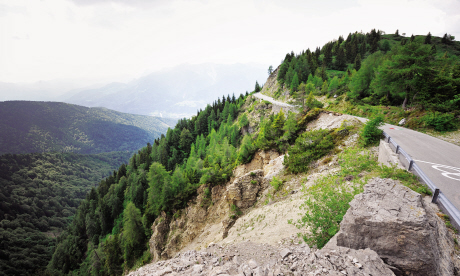 3. Monte Zoncolan, Italy
3. Monte Zoncolan, ItalyBefore its inclusion on the route of the 2003 Giro d’Italia, Monte Zoncolan was but one obscure peak among many in its vicinity, a rock face in an anonymous crowd of limestone giants. The least wealthy, least explored and least chronicled of the northern Italian regions, it stood to reason that Friuli should be home to some of Italy’s most mysterious and unloved mountains, as well as to its own indecipherable language.
With their unusual names, such as Fleons and Crostis, the Alps of the Carnic sub-range were also opposite in character to the docile Celts who settled and eventually submitted to Roman rule there. They were inhospitable in climate and in gradient.
The latter of these characteristics made them irresistible to cycling thrill-seekers. Altitude junkies had been whispering about Monte Zoncolan for years, even if they never made it to the summit. Internet forums and blogs named the ascent of the Zoncolan from Ovaro as the hardest paved climb in Italy – or at least rated it tougher than even the infamous Passo del Mortirolo. The women’s professional Giro d’Italia got to within three kilometres of the summit in 1997 – but ‘only’ via Sutrio and the significantly easier eastern side, on a road that gains elevation at a ‘modest’ average of 7% for 11 kilometres up to that point.
A year later, in 1998, Francesco Guidolin was a former professional footballer now managing the team based in the Friulan capital Udine, Udinese Calcio. Guidolin was also an avid cyclist and summit ‘collector’.
One afternoon at the Udinese’s summer training camp in Arta Terme, he set out on his bike with an old riding buddy. The friend whispered that he was about to let Guidolin in on a secret: it was 15 kilometres away and it was called the Monte Zoncolan. It was also, Guidolin’s friend assured him, like nothing else he’d ever seen, let alone climbed.
A regular visitor to Italy’s biggest races, Guidolin spread the word to his friends, the TV commentators Auro Bulbarelli and Davide Cassani, and to La Gazzetta dello Sport journalist Angelo Zomegnan. They in turn mentioned the Zoncolan to Giro d’Italia boss Carmine Castellano. In 2000, the Vuelta a España had unveiled maybe the hardest climb ever tackled by a professional race, the 12.55-kilometre, 9.9% Alto del Angliru, leaving Castellano scrambling for a riposte. The Zoncolan could be his Angliru. Or so he had hoped. Yet after his first recce, in 2001, the Giro chief was unconvinced. Sure it was steep, but it was also ‘little more than a donkey track’.
In 1939, around 400 men and a peloton of mules had begun trudging up the mountain every day with bags of cement, oblivious to the upturned inferno they were about to create. Within 18 months their work was done. Five years later, on March 2, 1945, they probably rued their efforts when Cossack troops piled into Ovaro via the new road and killed 22 civilians.
The Giro’s less tragic version of a massacre occurred in May 2003. Castellano had finally agreed to the ‘safe’ option of attacking the Zoncolan from Sutrio, perhaps reasoning that, in any case, only the aficionados knew the difference. Still, the favourites for that 2003 edition all visited the Zoncolan in the months leading up to the race and chorused their stupefaction. Gilberto Simoni test-rode the last three kilometres with a 39x27 gear and ‘almost had to get off and walk’; his team-mate Leonardo Bertagnolli, riding with a 39x25, didn’t even manage that – he turned back.
On the morning of the race, La Gazzetta christened the Zoncolan ‘The Pink Dragon’ and exaggerated that ‘half of Europe’ had been camped on the mountain for three days, such was the ‘incredible anticipation, decorated with dreams’. Having attacked on the steepest pitches to win alone, Simoni called the final kilometre ‘the hardest I’ve ever encountered’, while the sprinter Mario Cipollini’s use of a mountain bike for the same stretch was part-protest, part-publicity stunt.
The following day’s Gazzetta duly applauded the Zoncolan for ‘living up to its “Monster” billing’. And yet the real brute, of course, lay on the western side. Zomegnan, who succeeded Castellano as the Giro director in 2005, knew it, and he and local politician Enzo Cainero were soon conniving to unleash the beast in 2007. Locals who had once hacked down pine trees to create grazing lands were now dispatched to do the same job so that the road and the riders could be filmed from helicopters overhead. The cull cost the Zoncolan 300 trees – a small price for sporting notoriety that would span decades and the 170-odd countries to which the Giro was now broadcast.
In the months leading up to the race, the Giro riders again came, saw and swooned in amazement. The consensus among them was that the Zoncolan tackled from Ovaro was the ‘hardest climb in Europe’ and ‘much harder than the Mortirolo’.
After the first two relatively ‘normal’ kilometres to Liariis, the road narrowed and scarcely kinked for five kilometres; the average gradient in this section was 15.3 kilometres, the maximum well over 20. Simoni said it was like a slow, steady execution. ‘Mortifying’ was the adjective he used.
No matter: he triumphed again and in the process became ‘Signor Zoncolan’.
This time Simoni used a 34x27 and glorified his success with the verdict: ‘The easiest part of this climb is harder than the most difficult you ever get at the Tour de France’.
But the real star was, of course, the Zoncolan. Maybe most importantly, unlike other recent Giro discoveries, it seemed extreme but not gimmicky, and gave the impression of having lain dormant and undiscovered for centuries, in contrast to the equally steep but artificial Plan de Corones, another Zomegnan invention. The Zoncolan also had a distinctive visual identity; the narrow, almost entirely tree-lined road, three tunnels in the final two kilometres and the extraordinary natural grandstand at the summit, embedded the mountain immediately into the Italian national psyche. It wouldn’t be long before the Zoncolan had also infiltrated their colloquial language, like the Mortirolo before it.
Politicians needing to overturn a heavy deficit in opinion polls now had ‘a Zoncolan to climb’. Any kind of struggle against nature or the odds, be it on the sports field, in love or at the workplace, was now ‘as tough as the Zoncolan’.
The ‘Monster’s’ other, immediate, legacy was to accelerate the arms race in which Europe’s mountain roads had always been unwitting participants. The Tour de France had climbed its first mountain pass, the Col du Pin-Bouchain, in its inaugural 1903 edition, and six years later the first ever Giro d’Italia took its riders over the 684-metre-high, 3.5-kilometre long, 7.5% steep Valico del Macerone in the southern Molise region. Easy by modern standards, the Macerone appalled many of the riders, including eventual Giro winner Luigi Ganna. He punctured four times on its cinder surface and was reduced to tears.
The 1911 edition had seen the first ascent to over 2,000 metres, at Sestriere; the 1937 Giro made a first foray into the Dolomites, via the Passo Rolle; 1953 witnessed the maiden journey up the Stelvio; and 1990 saw the discovery of the Mortirolo.
With doping often rampant, some believed that cycling had already taken the Olympic imperative of ‘faster, higher, stronger’ too literally, and that the Zoncolan had upped the ante even further. No sooner had Simoni mopped his brow at the top and swung around to admire a simmering panorama of the Carnic Alps than the search for the next behemoth began literally under his nose. There was, murmured the experts, a third, even harder way up the Zoncolan, starting a kilometre to the south of Sutrio in Priola and joining the Sutrio road just where it became brutal, at the Rifugio Moro. This road had been tarmacked in 2006 and sure enough it was, with an average gradient of 12.9% over 8.9 kilometres, harder than the Ovaro side. Those in the know had dubbed it the ‘Zar’ (Italian for Czar) of the three approaches.
The truth of course was that the Zoncolan was never the ‘hardest climb in Europe’. It was just the hardest one deemed easy enough for professional road cyclists on conventional bikes. There was a road near Trento, the 7.5-kilometre, 17.6% Via Scanuppia, which made even the ‘Zar’ look like child’s play. That briefly excited the masochists until someone piped up that there was a climb even tougher than the Scanuppia, the road to Pozza San Glisente (8.2 kilometres at an average of 17.7% above Esine), not far from Brescia and the Lago d’Iseo. And no doubt another one somewhere else, that no one had either the folly or strength to mount or measure.
For the moment, the Zoncolan could at least bask in its status as Europe’s most infamous cycling climb, and, thanks to that (dis)honour, as perhaps Friuli’s best-known mountain. It was no longer just one obscure peak among many. The Monster, The Pink Dragon, the Zoncolan was above all a mountain whose awesome reputation now negated the need for silly sobriquets. The Zoncolan was, quite simply, ‘as tough as the Zoncolan’.
Region: Friuli-Venezia Giulia, Italy
Access: From Raveo go to Ovaro on the Via Pedrada (SS-335) until the crossroads with Via Lanjagnas, go right on Via Ex Ferrovia, do a U-turn and follow Via Barc, Via delle Scuole, Via Lenzone and Via Liariis
Height: 1,730m
Length: 10.1km
Altitude gain: 1,203m
Average gradient: 11.9%
Open: Depending on weather
Refreshments: Bars in Ovaro and at the top
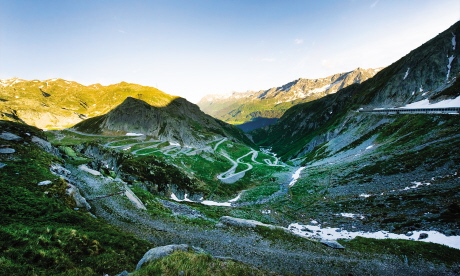 4. St Gothardpass, Switzerland
4. St Gothardpass, SwitzerlandBetter known to motorists than it is to cyclists, the St. Gotthardpass nowadays is either a whimsical detour or where car-bound passengers end up after a wrong turning before the 16.9-kilometre tunnel of the same name. One of three engineering marvels facilitating access over or through the Gotthard massif – the others being the pass and one of Europe’s most spectacular sections of railway – the tunnel was constructed in 1980 and has its own colourful and tragic history.
In 2001, it was closed for two months after a fire killing 11 people – a solemn echo of a more serious disaster in the shorter Mont Blanc tunnel in 1999. Today, on summer weekends, it is a horrendous bottleneck due to its location on a motorway that effectively
heads in a straight line for kilometres from Hamburg in Germany to the end of Italy’s
‘toe’ in Reggio Calabria.
Built to relieve traffic on the pass, the tunnel accomplished its mission much in the same way as its railway equivalent a century earlier. Not that the latter has ever been considered an unqualified success, having accumulated a death toll worthy of a small military campaign during its construction. The number of victims differs depending on the source you read, varying from 177 to 500, and certainly including the man who drew up and soon became totally absorbed by the project, Louis Favre. Accounts of working conditions throughout make the mind boggle: according to one report, a double bed in one dorm was occupied in succession by 24 different labourers in 24 hours.
Favre’s posthumous reward ought to have been unstinting praise for what Douglas Ashby described in his 1928 travelogue, Things Seen in Switzerland in Summer,
as the ‘that marvellous hole in the hills, the St. Gotthardpass tunnel’. Many were, and indeed still are, staggered by the architect’s achievement. Rather than a single channel from one side of the mountain to the other, the tunnel is in fact a series of burrows strewn up and through its flanks, until finally it emerges fully in the south. ‘And again the train plunges into a tunnel, like a huge black beast going into its den; and each time it emerges the landscape is different, either softer or more stern,’ Victor Tissot wrote of the view from the road pass in his book La Suisse Inconnue in 1888. Tissot, like other earlier travellers, seemed thrilled by the railway but concerned about its impact on what was previously the only way over the Gotthard, the pass. ‘We enter the valley of the Reuss, and follow the line of the old Gotthard road, poor forsaken thing, towards which the locomotive seems to send a mocking whistle as it goes’.
Charles Freeston’s 1910 High Roads of the Alps was less sympathetic; in Freeston’s mind the Gotthard road was getting what it deserved. ‘From the strictly motoring point of view it is possible to rate the St. Gotthardpass too highly,’ Freeston wrote, before adding, ‘As a railway route it is quite without a rival, neither the Mt Cenis nor the Simplon line being at all comparable with it in interest or picturesqueness.’
Not for the first or last time, the oldest and most attractive of any way over the Gotthard was somehow being treated as the mongrel of the litter. And yet its history was not only long but captivating and illustrious – more so than that of almost any other climb in this
compilation. With such rich heritage, of course, came inconsistency.
Many historians would have it that the Gotthard was first made accessible for pack mules by Emperor Charlemagne, dating it between the late 760s and his death in 814, but the first reliable documentation can’t be traced until 1230, when the Holy Roman
Emperor upgraded what was by then a vital access route to his territories in the land today known as Italy. Six centuries later, in 1832, the Gotthard became the carriage road now referred to as the ancienne route or ‘old road’ over the pass.
In the intervening centuries, the Gotthard’s strategic position between the Germanic and Latin halves of Europe placed it at the fulcrum of wars and epic journeys. Midway through the 13th century, it was included in the Annales Stradenses, the seminal reference for pilgrims from northern Europe heading for Rome. In 1403, the Gotthard was at the centre of a bitter and bloody power struggle between Milan in the south and the canton of Uri in
the north; also in the 15th century, Pope Pius II added his name to the many luminaries who have crossed the Gotthard.
Too many to mention have made the same voyage since then, but Charles Greville, the first person across the summit in a wheeled carriage in 1775, and Hans Christian Andersen, who came and bickered with a chauffeur over a taxi fare in 1852, perhaps deserve special citation.
Evidence of the pass’s long and mysterious past lies all around on the Gotthard, whether climbed from Airolo in the canton of Ticono, on the Italian-speaking south side, or from the north. Perhaps most famous of all of its artefacts, and what truly distinguishes the Gotthard from any other legendary mountain pass, is the old cobbled road or Tremolatrasse through the Val Tremola or Trembling Valley from Airolo. An extraordinary noodle of 38 tightly bunched hairpins, this is the only route permitted for cyclists on the southern side – not that anyone in their right mind would favour the main road.
Charles Freeston called the Tremola ‘grim rather than grand’ but went on to compare its windings to those of the Stelvio from Trafoi. Charles Merrick was of the same view, calling the Val Tremola a ‘marvel of engineering and a driving thrill’. In both cases, on the Gotthard and Stelvio, there can be no higher commendation than to say the road itself perhaps even eclipses the natural beauty of the surrounding summits.
The Gotthard’s own crest will not, it’s true, win any beauty contests. With a museum, three lakes and a monument to Adrien Guex, a Swiss airman who crashed his plane and died at the top in 1928, there is at least plenty to see. ‘The scene is not beautiful but it is impressive,’ said Merrick. While that may be true, numerous writers and travellers have noted the wonderful sense of transition when crossing the pass in the opposite direction, from north to south, from the last Germanic valley to a land of Italian speakers, Switzerland’s canton of Ticino.
‘We shall be unimaginative indeed if we do not feel the warm breath of the south come up to meet us,’ cooed Douglas Ashby. Victor Tissot more or less echoed him: ‘The
delight of people from the north may be imagined when they thus find themselves suddenly transported into a kind of promised land, into the midst of a sunny, blooming scene, with the freshness of an oasis, fragrant as a garden under a soft blue sky in which light clouds rise and disappear like a distant flight of wild birds.’
There is less to inspire the cyclist further down the wide, smooth and sterile road to the
summit from Hospental. Although the Tour of Switzerland has climbed the Gotthard more than any other mountain (35 times up to 2010), and often from this side, those visits have spawned considerably fewer legends than, say, the Devil’s Bridge across the Schöllenen Gorge in Göschenen, on the approach to Hospental. A meandering tale goes
that a local herdsman hoodwinked the devil into building the bridge and, on realizing, the devil reached for a rock with the intention of smashing it. An old woman saw him and promptly drew a cross on the rock, making it impossible to lift. The cross and 220-tonne rock are still there today, as are two bridges, one built during the construction of the main Gotthard pass road in 1830 and now closed and, above it, the main 1955 structure. Look hard and you’ll also see the abutments of the first footbridge across the gorge, built in
1595 and destroyed by a storm in 1888.
Perhaps it was to tales like this that Charles Freeston was referring when he talked about the ‘glamour’ of the Gotthard. If by glamour he also meant history, importance and
one of the most unusual stretches of mountain road anywhere in the Alps, he may never have penned a truer word.
Region: Canton of Uri, Switzerland
Access: From the centre of Andermatt, follow signs to the Gothard pass, then in
Hospental follow signs marked Zum Sankt Gotthar or Alte Gotthard-Strasse (old St.Gotthard road) and you'll reach the main road for cyclists.
Height: 2,106m
Length: 8.6km
Altitude gain: 610m
Average gradient: 7.1%
Open: June to October
Refreshments: Several bars at the bottom, in Mätteli (km 4) and at the top
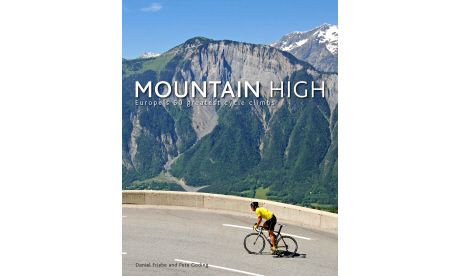 A stunning showcase of Europe’s 50 greatest climbs, including detail on routes, maps, profile and compelling descriptions featuring places of interest along the route. From experienced club racers to enthusiastic amateurs, Mountain High is book is for cyclists of all abilities. Buy your copy on Amazon now.
A stunning showcase of Europe’s 50 greatest climbs, including detail on routes, maps, profile and compelling descriptions featuring places of interest along the route. From experienced club racers to enthusiastic amateurs, Mountain High is book is for cyclists of all abilities. Buy your copy on Amazon now.
Check out our cycling and mountain biking travel guide for more tips, tops routes and articles | Plan a trip... More
Matt Carol's top 5 English cycle rides | Good for burning off those extra X-Mas pounds! | Inspire me... More
The beginner's guide to cycle touring | Advice... More
Border-hop around Europe by bicycle | Destinations... More
10 great cycling destinations around-the-world | Inspire me... More
